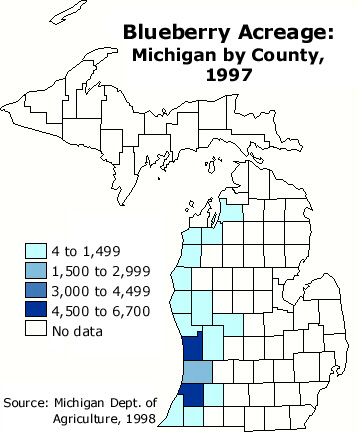
Michigan leads the nation in blueberry
production, producing nearly 45% of the blueberries eaten
in the U.S. In 1997, the state produced 76 million pounds
of the small, round berry.
Acidic soil is required to grow
blueberries, along with adequate water and cool
temperatures. Low growing season temperatures allow a
dormant period for blueberry bushes, a climatic factor
that promotes higher yields. Allegan, Berrien, Muskegon,
Ottawa and Van Buren counties on the western side of
Michigan's lower peninsula comprise the state's primary
blueberry growing region. Harvest season begins in
mid-July and ends in late September.
Source: Photograph by Randy Schaetzl, Professor of Geography - Michigan State University
When buying blueberries, look for
firm, plump berries that have a powdery, grayish-blue
color. To prevent fresh berries from turning soft, wash
them just before eating. When storing, wrap tightly and
refrigerate. Do not wash them before freezing. If washed,
they turn into a solid form and become mushy upon
thawing. Instead, blueberries should be frozen so they
pour individually from an air-tight bag or container.
Blueberries grow on small woody bushes, making picking
very easy and enjoyable.
Source: Photograph by Randy Schaetzl, Professor of Geography - Michigan State University
Source: Photograph by Randy Schaetzl, Professor of Geography - Michigan State University
BLUEBERRIES.....the Brain Food
(this from Newsweek, June 12, 2002)
Think of berries (all of them) as antioxidant
pills—without the need for a visit to the pharmacy.
Antioxidants help prevent cellular damage caused by
compounds called free radicals. A few years ago Tufts
scientists measured the antioxidant levels of 50 fresh
fruits and vegetables, and found the top slots were
occupied by berries. Much of that antioxidant strength
comes from the anthocyanin pigments that tint berries
red, purple and blue. The darker the berry, the stronger
the protective pigments. In April, physiologist David
Bell of the Indiana University School of Medicine
reported that extracts of a dark berry called the
chokeberry completely shielded coronary arteries in
test-tube studies against free radicals that are a prime
culprit in heart disease.
And when it comes to brain protection, there’s
nothing quite like blueberries, according to Tufts
neuroscientist James Joseph, coauthor of “The Color
Code,” a new book about the virtues of eating
colorful foods. In one set of tests, Joseph put rats into
chambers containing 100% oxygen to mimic the oxidative
damage accompanying brain aging. Unprotected rats seemed
to age overnight, but blueberry-fed rats had no damage at
all. In his best-known set of experiments, aging
blueberry-fed rats showed actual improvements on
cognitive and motor-skills tests. “I call the
blueberry the brain berry,” says Joseph, who
attibutes the effects to its antioxidant and
anti-inflammatory compounds.
Berries also show promise in helping to ward off cancer.
Microbiologist Lyndon Larcom at Clemson University has
just completed a series of test-tube studies indicating
that both strawberries and raspberries can block
carcinogens of two classes—some that are directly
toxic, others that are activated by the body’s own
metabolic processes.
How many berries do we need to eat? No one really knows.
But this spring the National Cancer Institute launched a
campaign called Savor the Spectrum, urging Americans to
eat fruits and vegetables from each color group every
day—orange, red, green and blue-purple. Berries are
among the rare blue and purple foods. With the USDA Food
Guide Pyramid recommending five to nine servings of
produce daily, says Stoner, “let one of your daily
helpings of fruit be berries of some sort.” It seems
they’re berry, berry good.
Soooo.....eat more blueberries!
Source: Photograph by Randy Schaetzl, Professor of Geography - Michigan State University
This material has been compiled for educational use only, and may not be reproduced without permission. One copy may be printed for personal use. Please contact Randall Schaetzl (soils@msu.edu) for more information or permissions.